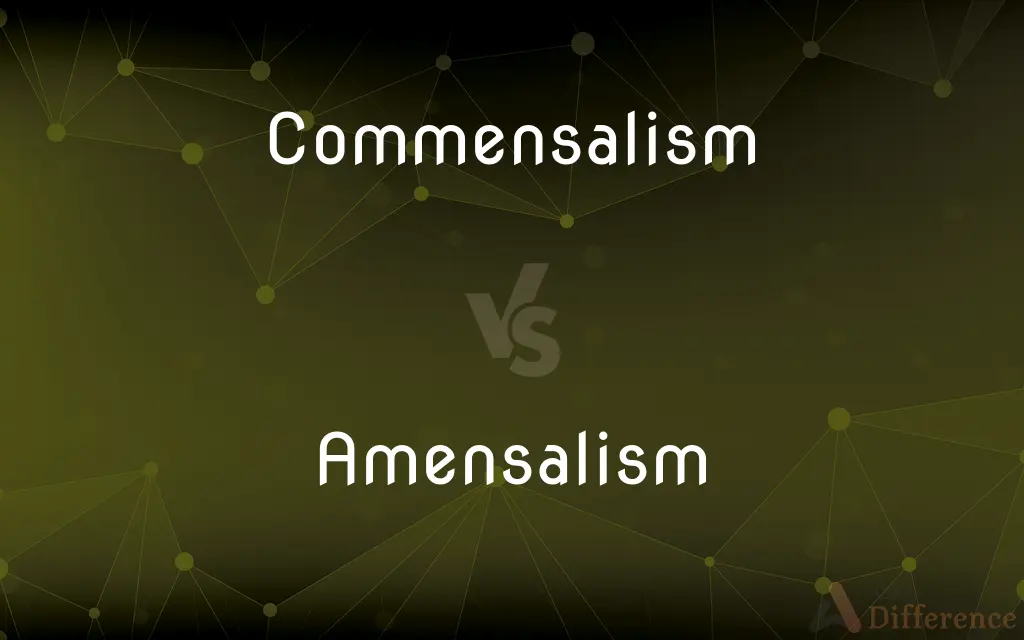Commensalism vs. Amensalism — What's the Difference?
By Tayyaba Rehman & Urooj Arif — Updated on March 20, 2024
Commensalism is a symbiotic relationship where one organism benefits without affecting the other, while amensalism involves one organism being inhibited or damaged and the other remaining unaffected.

Difference Between Commensalism and Amensalism
Table of Contents
ADVERTISEMENT
Key Differences
Commensalism represents a type of ecological interaction where one participant, the commensal, gains benefits such as nutrients, shelter, or support, without impacting the host organism's well-being. This relationship can be seen in various ecosystems, for instance, barnacles attaching to whales. On the other hand, amensalism involves an interaction where one organism is harmed or inhibited, and the other is unaffected. A classic example of amensalism is the relationship between large trees and the smaller plants growing in their shade. The trees, by simply existing and blocking the sunlight, hinder the growth of smaller plants without gaining or losing anything themselves.
In commensalism, the beneficiary often relies on the host for a specific advantage that enhances its survival or reproduction, without engaging in any form of harm or mutual benefit to the host. Conversely, amensalism typically involves a competitive aspect where the inhibiting organism, often unknowingly, restricts the growth, reproduction, or survival of another organism through chemical exudation, physical barrier creation, or resource monopolization.
The ecological impact of commensalism can be neutral for ecosystems, as it doesn't typically involve significant changes to the populations involved. However, amensalism can have more pronounced ecological effects, potentially leading to the suppression of certain species in a habitat, which can alter community structures and dynamics.
Both commensalism and amensalism highlight the complexity of ecological interactions and the diverse strategies organisms have evolved to coexist. While the former underscores the potential for organisms to exploit niche opportunities without harming others, the latter exemplifies the competitive pressures within ecosystems that can lead to exclusion or adaptation.
Despite their differences, both types of relationships are important for understanding ecological balance and the intricate web of interactions that sustain ecosystems. They exemplify how organisms adapt to their environment and each other, shaping the biodiversity and functionality of ecological communities.
ADVERTISEMENT
Comparison Chart
Definition
A symbiotic relationship where one organism benefits and the other is unaffected.
A relationship where one organism is harmed or inhibited and the other is unaffected.
Example
Barnacles growing on whales.
Large trees overshadowing undergrowth.
Beneficiary Impact
Gains benefits such as nutrients, shelter, or support.
Unaffected.
Other Party Impact
Unaffected.
Harmed or inhibited, often by competition or chemical means.
Ecological Significance
Generally neutral, can enhance biodiversity through niche exploitation.
Can lead to suppression of species, affecting community structure.
Compare with Definitions
Commensalism
Commensalism is a relationship where one organism benefits and the other is not affected.
Remoras riding on sharks to feed on scraps.
Amensalism
Antibiotic production by fungi is an example of amensalism.
Penicillium mold secreting penicillin, which kills bacteria.
Commensalism
Birds nesting in trees is a form of commensalism.
The tree offers support for nests without harm or benefit.
Amensalism
Large animals trampling smaller plants exhibit amensalism.
Elephants walking through a forest can crush undergrowth.
Commensalism
Commensal species can exploit human environments.
House sparrows thrive in urban areas, utilizing structures for nesting.
Amensalism
Amensalism can result from resource competition.
Tall plants shading out smaller plants, limiting their access to sunlight.
Commensalism
Commensal fungi grow on living plants without causing disease.
Certain orchids grow as epiphytes on larger trees.
Amensalism
Amensal interactions can occur in microbial communities.
Some bacteria produce substances harmful to other microbes nearby.
Commensalism
Some commensal relationships involve protection.
Small fish gain protection by swimming near larger predatory fish.
Amensalism
Amensalism occurs when one organism is inhibited and the other unaffected.
A walnut tree releasing juglone to inhibit surrounding plant growth.
Commensalism
A symbiotic relationship between two organisms of different species in which one derives some benefit while the other is unaffected.
Amensalism
An association between two organisms of different species in which one is harmed or inhibited while the other is unaffected.
Commensalism
(ecology) A sharing of the same environment by two organisms where one species benefits and the other is unaffected. An example is barnacles on whales.
Amensalism
(ecology) A form of symbiosis in which one species is harmed or impeded and the other is unaffected.
Commensalism
The act of eating together; table fellowship.
Commensalism
The act of eating together; table fellowship.
Commensalism
The relation between two different kinds of organisms when one receives benefits from the other without damaging it
Common Curiosities
How does amensalism differ from competition?
Amensalism involves one organism being harmed while the other is unaffected; in competition, both organisms are negatively affected as they vie for the same resource.
Is commensalism beneficial for ecosystems?
Commensalism is generally neutral for ecosystems but can contribute to biodiversity by allowing species to exploit different niches without harming others.
Can amensalism affect ecosystem diversity?
Yes, amensalism can influence ecosystem diversity by inhibiting or eliminating certain species, which can alter community structures.
Can relationships between organisms change from commensalism to amensalism?
Yes, relationships can shift depending on environmental conditions, organism growth, or changes in the organisms themselves.
What are the conservation implications of understanding commensalism and amensalism?
Understanding these interactions can help in conservation efforts by highlighting the importance of maintaining balanced ecosystems for species survival.
What defines a commensal relationship?
In commensalism, one organism benefits from the relationship, while the other remains unaffected, neither harmed nor helped.
What role do amensal relationships play in natural selection?
Amensal relationships can drive natural selection by inhibiting certain species, potentially leading to adaptations or changes in community dynamics.
Are there any positive outcomes of amensalism?
While generally negative for the affected organism, amensalism can lead to increased resilience or adaptive strategies in affected populations.
Are humans involved in commensal or amensal relationships with other species?
Yes, humans participate in both types of relationships, such as commensal organisms benefiting from human environments or amensal impacts through pollution or habitat destruction.
Can an organism be part of both commensal and amensal relationships?
Yes, an organism can engage in commensal relationships with some species and amensal relationships with others.
How is commensalism identified in nature?
Commensalism is identified by observing an organism benefiting from another without affecting it, often through detailed ecological studies.
How does amensalism influence plant communities?
Amensalism can significantly impact plant communities by inhibiting growth or survival of certain plants, leading to changes in species composition.
How do scientists study amensalism in the lab?
Scientists can study amensalism by creating controlled environments where they can observe the effects of one organism's actions on another.
Can commensalism lead to dependency?
In some cases, the commensal organism may become dependent on its host for certain benefits, though this is not a defining feature.
Share Your Discovery

Previous Comparison
Immigrant vs. Refugee
Next Comparison
Science vs. PhilosophyAuthor Spotlight
Written by
Tayyaba RehmanTayyaba Rehman is a distinguished writer, currently serving as a primary contributor to askdifference.com. As a researcher in semantics and etymology, Tayyaba's passion for the complexity of languages and their distinctions has found a perfect home on the platform. Tayyaba delves into the intricacies of language, distinguishing between commonly confused words and phrases, thereby providing clarity for readers worldwide.
Co-written by
Urooj ArifUrooj is a skilled content writer at Ask Difference, known for her exceptional ability to simplify complex topics into engaging and informative content. With a passion for research and a flair for clear, concise writing, she consistently delivers articles that resonate with our diverse audience.














































